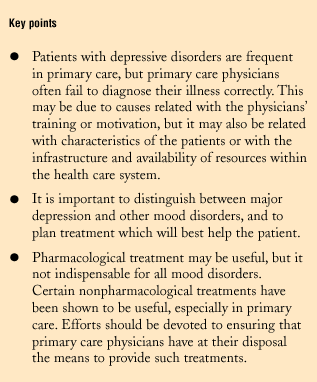Depression is one of the most frequent of all mental disorders. Its basic repercussions on health are evident: it leads to considerable disability and suffering in those affected, is associated with a high percentage of suicides (15%-20% of all cases of major depression, according to some estimates1), and generates considerable social and health care costs.
The Global Burden of Disease report for 20002 noted that unipolar depressive disorders represent an extraordinarily large contribution to the burden of disease in society, and are the most frequent cause of years of life lived with disability (YLD). These disorders account for 11.9% of all YLD in the population of persons 15 to 44 years old (9.7% in men, 14.0% in women). However, of even greater concern is the fact that their frequency is expected to rise in the next 20 years, especially in developed countries. However, there have been repeated indications that current health systems underdiagnose depressive disorders. Approximately 50% of all patients with depression are not identified in primary care settings.
The article in this issue by Gabarrón Hortal et al documents underdiagnosis and identifies the characteristics of persons in whom depressive disorder is most likely to be overlooked: women, widows and widowers, retired persons, those with recent antecedents of stressful life events, and frequent users of health care services.
The study found a diagnosis of depression in 20.2% of all persons in the sample; the much higher frequency in women (26.8%) than in men (8.1%) was noteworthy. Perhaps the high prevalence of depression, which was somewhat greater than that reported in other Spanish studies of primary care users,3,4 was the result of the inclusion of cases of dysthymic disorder, as the authors themselves note.
Despite the high prevalence of this disorder, most expert group recommendations find no reasonable motives to use systematic screening or structured interviews in the entire population of users. However, they do recommend that special attention be given to subpopulations with risk factors for depression, which would include frequent users, persons who have suffered stressful life events, and widows or widowers. The high prevalence in women also makes this group worthy of particular attention.
The first step to improve the current situation regarding this important health problem is to correctly detect cases, and the article by Gabarrón et al is devoted to this part of the process. Once the disorder is detected, the next relevant question that needs to be raised is how to best treat these cases. If one of every four women and one of every 12 men is assumed to be suffering from depression (as suggested by the findings of Gabarrón et al), an appropriate treatment strategy that makes rational use of available resources should be developed both for general primary care and mental health primary care. Recalling that such resources are limited, it may not be possible to provide optimum treatment for many of the cases detected.
The second question that arises is what to use to treat patients with depression. In recent years many clinical practice guidelines and expert group recommendations have been published--many of them evidence-based5--to provide practitioners with technical tools to improve the treatment of patients with depression. Technical aids are necessary, but not sufficient. Antidepressant medication has been shown effective, and recent years have seen the appearance of drugs with fewer side effects, which are easier for primary care physicians to use. Most studies have found these newer drugs, regardless of which family of pharmacological substance they belong to, are effective in 50%-60% of the cases, in comparison to the 30%-40% rates for placebos. But other strategies such as problem-solving therapy and group therapy are available too, and the health care system should reflect upon the need for these approaches, which, if used appropriately, can be effective for certain patients.
Before the type of therapy is chosen--for use alone or with a complementary approach--the disorder must be accurately categorized. Dysthymia is not the same as major depression, nor should so-called minor depression always be treated with drugs. The therapeutic strategies available for each type of disorder are different. One thing, however, seems clear: antidepressants should be accompanied by appropriate follow-up care within the framework of an overall therapeutic project which should include psychological support treatment, to the extent that this is possible within the time constraints that primary care physicians work under. If an epidemic is approaching--as the data now in hand suggest--the option of exclusively pharmacological treatment might turn a large portion of the population (as large as that now represented by habitual users of antihypertensives or lipid-lowering drugs) into habitual consumers of antidepressants. Other nonpharmacological strategies, such as problem-solving therapy, have been shown to be effective in 70% of all cases of depression in primary care if managed by appropriately trained professionals, and may improve the situation in the future. However, this approach to treatment requires additional training and spending more time with the patient.
Meanwhile, with the means currently within our reach, primary care professionals will need to content themselves with improving their skills and diagnostic precision to distinguish between patients who, on the basis of their particular characteristics, can be treated by a family physician, and those who, because their disease is more severe, should be referred to a mental health center or who are at risk of suicide. A good patient relationship between health care providers and the patient, the judicious use of antidepressants when indicated, and appropriate follow-up may, represent a step forward and may offer incentives to exploring new avenues of treatment for these patients.









